Can You Eat Cereal with Braces? Find Out What’s Safe and What’s Not
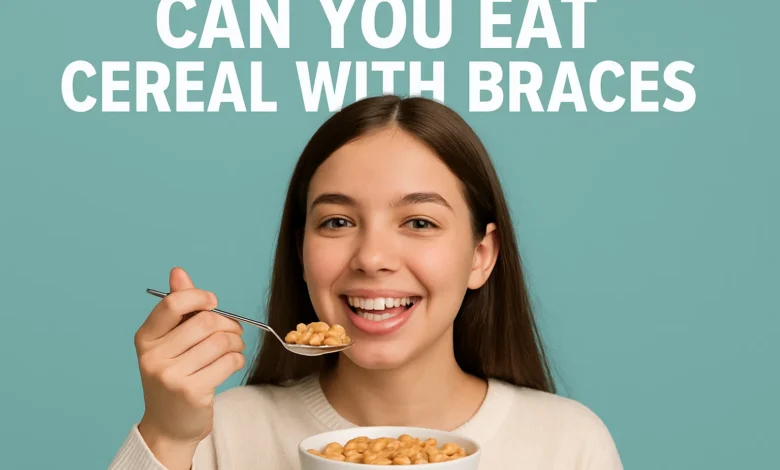
Can You Eat Cereal with Braces? A Complete Guide to Eating with Braces
Introduction
In the beginning stages of getting braces, one of the most worrying issues revolves around food. This concern is quite common and revolves around the wires, brackets, and even the rubber bands sensitive to sugars. One such concern that people seem to have is, “Will I be able to have breakfast cereals with braces?” The answer to that is simple, but to really be able to answer that with ‘yes’ you need to be careful not to damage your braces.
In the following sections, we will be discussing whether or not you can have cereals with bracesand the most suitable ones for you, and helping you with simple ways to wear braces while having cereals. The guide was designed to not only help you with informed decisions on what cereals to eat with braces but also to tell you what to avoid.
1. What Are Braces and Why Are They Important?
Braces are a type of dental apparatus utilized in orthodontics for the straightening of teeth and correction of bites. Operational components of braces are brackets, wires and rubber bands. Braces function by applying gentle pressure which over time shifts the teeth into the desired position.
Braces are essential for correcting various dental issues, including:
Crooked teeth
Overbite
Underbite
Crossbite
Spacing issues
Braces are installed for both functional and aesthetic purposes; they enhance one’s smile and improve one’s bite, making it easier to chew, talk, and practice good oral hygiene. However, some foods should be avoided or consumed with care to avoid damaging brackets and wires while one is undergoing orthodontic treatment.
2. How Braces Work and Why Diet Matters
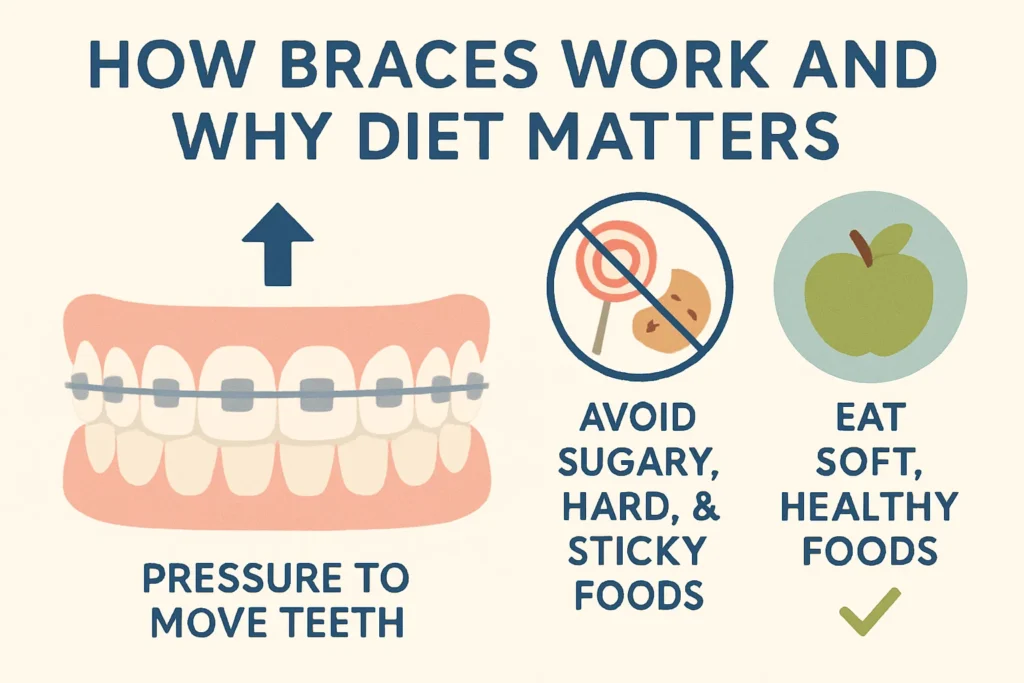
Braces function through the application of steady pressure to teeth which leads to their gradual movement into better positions. The continuous pressure from braces leads teeth to shift into their optimal positions. The wires which connect to the brackets serve as directional tools to help your teeth achieve proper alignment. Proper care of your braces remains essential during treatment since wrong food choices and inadequate oral hygiene can both slow down progress and lead to tooth decay and gum disease and broken brackets.
Diet plays a crucial role in the success of your orthodontic treatment. Certain foods can:
Harm or damage the braces, causing broken brackets or loose wires.
Increase plaque buildup, which can lead to cavities and gum disease.
Cause discomfort or pain, especially when the teeth are still adjusting to the braces.
3. Can You Eat Cereal with Braces?
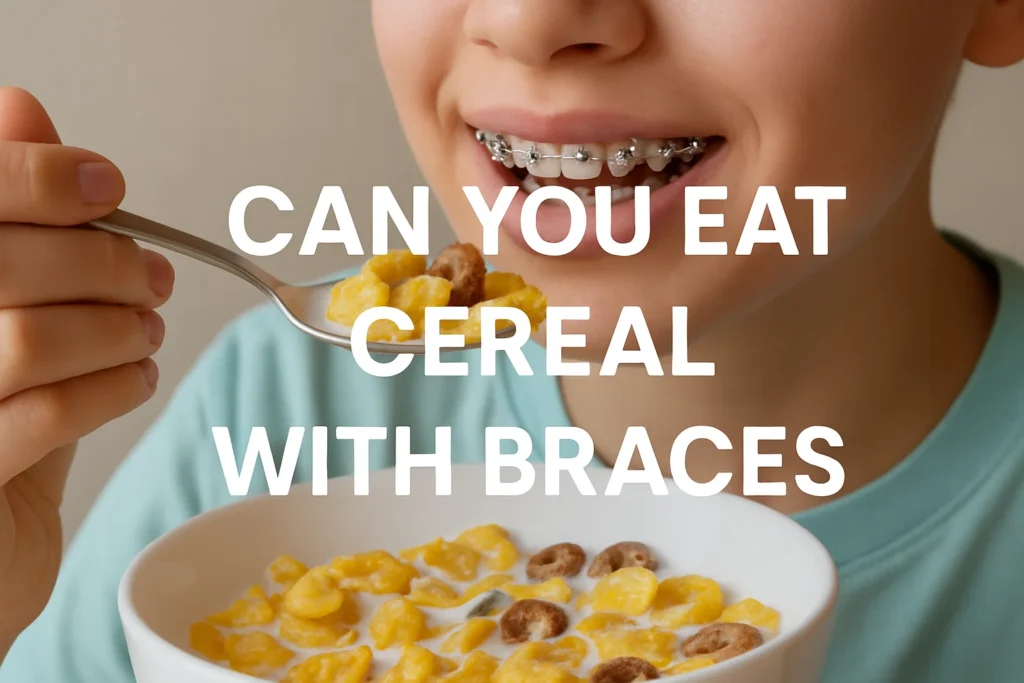
Individuals routinely inquire about the consumption of cereal following the application of braces. The good news is yes, you can consume cereal while having braces, though with certain restrictions. Cereal is suitable as a breakfast meal or a snack during the orthodontic treatment as long as the right types of cereal are chosen and the proper chewing methods are observed.
Soft Cereal Options for Braces
Soft cereals serve as an ideal breakfast option for people with braces during their initial sensitive period. Soft cereals are simple to chew while avoiding any additional pressure on your teeth which helps prevent discomfort.
Here are some soft cereal options that are braces-friendly:
Oatmeal: A warm and soft cereal that is easy to chew and doesn’t require much effort. You can add fruits, honey, or cinnamon for extra flavor.
Cream of Wheat: This is another warm, soft cereal that is easy on the teeth and ideal for braces wearers.
Rice Cereal: Soft, quick to prepare, and easy to chew, rice cereal is a good option for people with braces.
Bran Flakes (with Milk): When softened with milk, bran flakes can be an excellent choice for a more fiber-rich breakfast.
Hard and Crunchy Cereal to Avoid
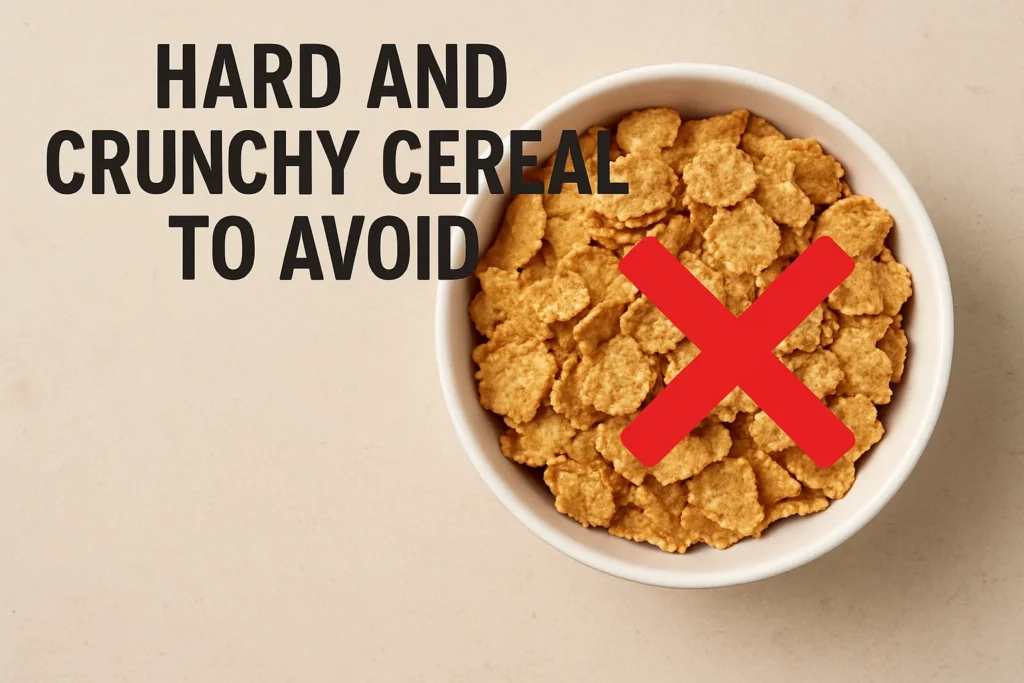
Soft cereals are safe to eat but hard crunchy cereals should be avoided especially during the first few months of braces treatment. The hard texture of these cereals poses a risk to damage your braces brackets and wires while eating and may cause discomfort during chewing. Certain cereals have such a hard texture that they can exert too much pressure on your teeth which may result in pain or breakage of your braces.
Here are some crunchy cereals to avoid:
Cornflakes: While it’s a classic cereal, cornflakes can be too crunchy and may irritate your braces.
Granola: Granola can be tough on your teeth and may get stuck in the brackets, making it harder to clean.
Cheerios (if eaten dry): Cheerios are somewhat crunchy when eaten dry and can cause discomfort if you have sensitive teeth from braces.
Rice Krispies (dry): Rice Krispies, when eaten dry, are not the best choice, as their crunchiness can damage your braces.
To minimize the risk of damaging your braces, it’s essential to soften the cereal by adding milk or soaking it for a few minutes before eating.
4. Tips for Eating Cereal with Braces
While it’s generally safe to eat cereal with braces, there are a few tips and tricks you can use to make the process easier and more comfortable.
How to Make Cereal Braces-Friendly
Loosen the Cereal: To ease the process of chewing if you have sensitive teeth, allow your cereal to soak in milk for one or two minutes. This softens the texture and makes it easier to chew.
Don’t Crunch: Do not exert excessive force to bite down on the cereal. To prevent your braces and teeth from sustaining damage, chew slow, gentle, and calm to avoid too much pressure.
Pick Low Sugar Cereals: Eating cereals which are high in sugar will eventually encourage the formation of plaque which increases the chances of having cavities. It is better to choose low-sugar or sugar-free cereals and then trying to keep the teeth brushed right after.
Best Practices for Braces Wearers When Eating Cereal
As long as you are wearing braces, remember to only use spoons when eating cereal. To avoid conflict with the braces, avoid biting on to anything hard as this could break braces wires.
Nuts and dry fruit are considered hard add-ons, and should not be added to cereal in the initial weeks of wearing braces. The mentioned hard add-ons can get stuck between brackets which leads to discomfort.
5. Other Foods to Avoid When You Have Braces
While cereal is one of the main food groups people wonder about with braces, there are many other foods that should be avoided or eaten with caution to prevent damaging your braces or causing discomfort.
Hard Foods
Nuts, hard candy, and popcorn are prohibited due to their potential to damage wires and brackets.
Sticky Foods
Caramel, taffy, chewing gum, and gummy candy are classified as sticky foods. Such foods can get trapped in brackets, making removal difficult and resulting in plaque and cavity formation.
Chewy Foods
Bagels, candy bars, and steak can be consumed, but in moderation. These foods are excessively chewy, and can be painful to consume due to their tendency to damage braces.
6. Common Issues with Eating Cereal and Braces
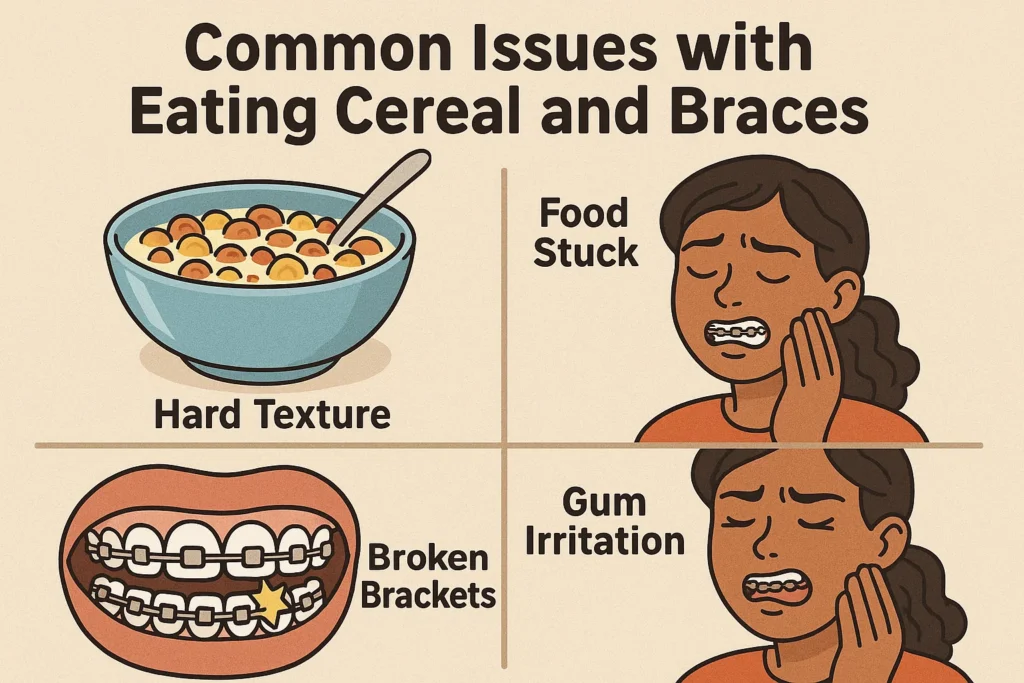
Eating cereal with braces can sometimes present some challenges. Here are a few common issues you may face and how to resolve them:
Cereal Getting Stuck in Braces
Cereal, especially the smaller, crunchier varieties, can get stuck between the brackets and wires. To prevent this:
Brush your teeth after eating to remove any cereal particles.
Use an interdental brush to clean between the brackets and wires.
Discomfort from Eating Hard or Crunchy Cereal
If you experience discomfort when eating cereal, it may be a sign that your teeth are still adjusting to the braces. In this case:
Switch to softer cereals that are easier to chew, like oatmeal or cream of wheat.
Use orthodontic wax to cover any sharp or uncomfortable areas of your braces.
7. How to Care for Your Braces After Eating Cereal
Braces, much like other dental appliances, require special attention after meals to ensure they are well kept and that there are no dental health complications which arise. Below are a few steps to follow after consuming cereal while wearing braces:
Tooth Brushing: As part of proper hygiene, always ensure that you brush after every meal. This helps clear food remnants and plaque which are likely to build between meals.
Braces and Wire Flossing: With the help of specially designed dental floss, either applique or orthodontic, scrub the small gaps that exist between the wires and brackets.
Use of Mouthwash: Rinsing your mouth with mouthwash after meals aids in the removal of bacteria which could lead to the formation of cavities.
8. What to Do If Cereal Gets Stuck in Your Braces
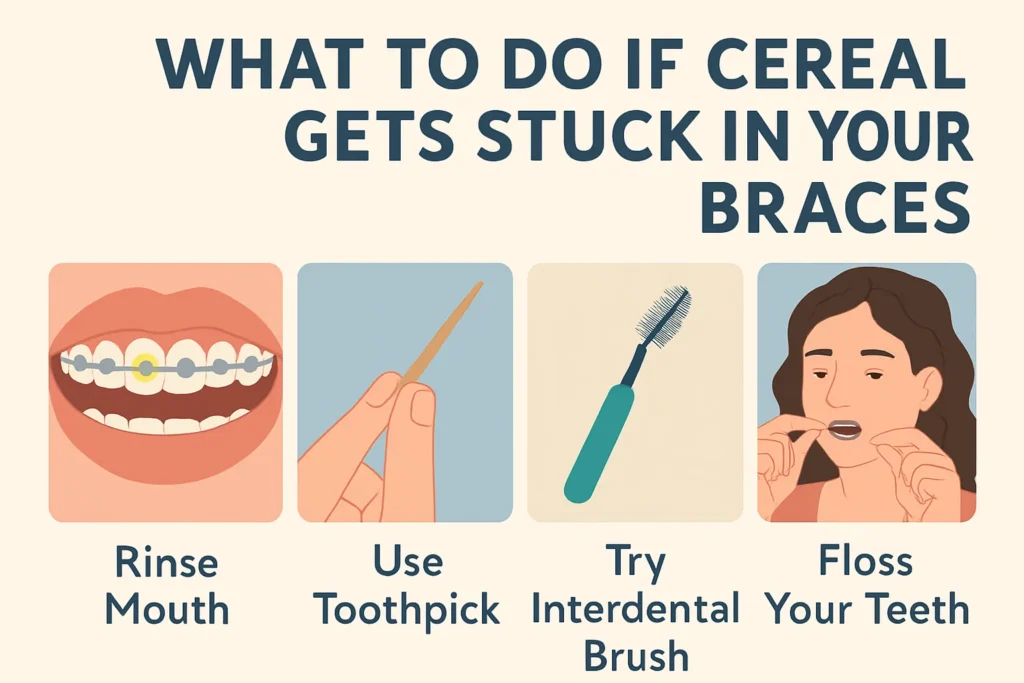
You should remove stuck cereal from your braces right away because delayed removal leads to plaque formation. Here’s what you can do:
A water flosser serves as a tool to remove food bits that become trapped between your braces.
Orthodontic Wax: If the cereal causes irritation to the inside of your mouth, apply orthodontic wax to the brackets or wires.
The interdental brush provides better cleaning access between brackets and wires than standard floss does.
9. Should You Avoid Milk with Braces?
Drinking milk with braces does not pose any safety risks. Milk serves as an excellent dietary source of calcium which helps build stronger teeth. When you have braces you should use milk to soften your cereal because it makes the food easier to chew and reduces the risk of irritating your braces.
10. Final Thoughts: Making Cereal a Part of Your Braces Diet
Consuming breakfast cereal is plausible with the use of techniques that observe certain guidelines. Stick with oatmeal as opposed to crunchy varieties that could damage your braces. With the right orthodontic care and food choices, oatmeal or soft breakfast cereals that provide the necessary nutrients could be eaten without any pain or risk of injuring the braces.
For effective management of the initial phase of brace wear, meal times and oral hygiene need to be managed more carefully. Orthodontic treatments position braces to specific teeth, the careful selection of brace-friendly foods promotes the healing of tissues, which subsequently result in greater comfort.
Can You Eat Marshmallows with Braces? Tips for Enjoying Sweets Safely


